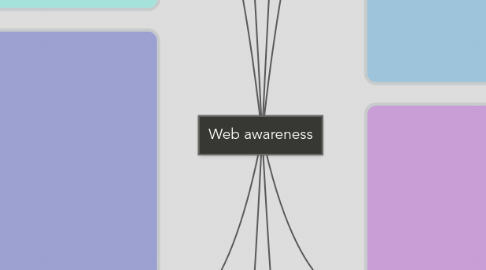
1. Privacy
1.1. Audience
1.1.1. It can be read and seen by anyone
1.1.2. Access personal information, pictures and videos published
1.2. Anonymity
1.2.1. Use a fake name to disguise identity
1.2.2. "Digital footprint"
1.3. Permenance
1.3.1. May be seen for years
1.3.2. Never really "erases"
1.4. Copyright
1.4.1. Do not copy without the proper credibility
1.4.2. Common Courtesy but also the law
1.5. Free speech
1.5.1. You have the freedom of speech
2. Internet Safety
2.1. Filtering systems
2.2. Digital and media literacy
2.2.1. Media issues
2.2.1.1. "Belief that thin is beautiful in our culture"
2.2.2. Digital issues
2.2.2.1. "Sexting"
2.2.3. Educational games
2.3. Internet concerns
2.3.1. Blogging
2.3.2. File sharing
2.3.3. Online gaming
2.3.4. Social networking
2.3.5. Video sharing
3. Sexual Explicit Material
3.1. How children are exposed to this material
3.1.1. Accidentally
3.1.1.1. Come across content on television/internet
3.1.1.2. Will affect child before they determine it is innapropriate
3.1.2. Intentionally (Curious)
3.1.2.1. Turn to internet to seek information
3.1.2.2. Children are curiously exposed to harmful material
3.2. Impacts of Overexposure
3.2.1. Shapes sexual values
3.2.2. Initiate them the experiment with sexual behaviour
3.2.3. Change appearance and behaviour
3.2.4. Interfere with healthy sexual development
3.3. What can Parents do
3.3.1. Become aware of what children are viewing and playing
3.3.2. Set up content filtering on search engines
3.3.2.1. Go to google, click on Advanced Search and Preferences, then click on filter using Safe Search
3.3.3. Fostering healthy body image
3.3.4. Supervising children online and offline
4. CyberBullying
4.1. Using electronic communication to bully a person
4.1.1. Many forms: sending messages, pictures and threats
4.1.2. Also bullied in person as well
4.2. Effects of children who are cyberbullied
4.2.1. Use alcohol and drugs
4.2.2. Skip school
4.2.3. Receive poor grades
4.2.4. Have lower self esteem
4.2.5. Have more health problems
4.3. Prevent cyberbullying
4.3.1. Establish rules about technology
4.3.2. Be aware of what your children are doing online
4.3.3. Ask for passwords of social media sites
5. Copyright
5.1. Why have copyright
5.1.1. Reward author for his/her efforts
5.1.2. Deals with exceptions to infringement
5.2. Who can copyright
5.2.1. First owner of the copyright in a work is the author
5.2.2. The form of expression has to be original and not copied from another work
5.3. How is it protected
5.3.1. Copyright owner can go to court to stop a person
5.3.2. Fines involved
6. Authenticity
6.1. The internet provides us with unlimited information which the sources that are unknown
6.1.1. Become critical consumers of the information
6.2. Evaluating internet information
6.2.1. Authority
6.2.1.1. Is the page signed?
6.2.1.2. Is contact info for the author available?
6.2.1.3. Are the authors qualifications available?
6.2.2. Coverage
6.2.2.1. Is the information relevant to your topic?
6.2.2.2. How in-depth is the material?
6.2.3. Objectivity
6.2.3.1. Is the page free of ads or sponsored links?
6.2.3.2. Does the info show a minimum of bias?
6.2.4. Accuracy
6.2.4.1. Is the information reliable and error free?
6.2.5. Currency
6.2.5.1. Is the page dated?
6.2.5.2. When was the last update?
7. Marketing
7.1. Pester Power
7.1.1. Children ability to nag their parents
7.1.2. Kids now have more decision-making power within the family
7.2. Psychology and Marketing
7.2.1. Advvertisers have access to in depth knowledge about children
7.2.2. Developmental, emotional and social needs
7.3. The internet
7.3.1. Kids are often online alone
7.3.2. The internet is unregulated
7.4. Commercialization in Education
7.4.1. Supplying schools with technology in exchange for high company visability
8. Awareness for teachers
8.1. Pose a threat to students
8.1.1. Unhealthy sites
8.1.2. Too much personal information
8.1.3. Platform to sell commercial products
8.1.4. Property of authors
8.2. Issues
8.2.1. Safety on the web
8.2.2. Authenticity
8.2.3. Copy and pasting
8.2.4. Marketing to kids
8.3. Approaches to address saftey
8.3.1. Educational games
8.3.2. Analogies and stories
8.3.3. Role playing
8.3.4. Guest speakers
8.3.5. Through a school wide program
8.3.6. Third party resource
